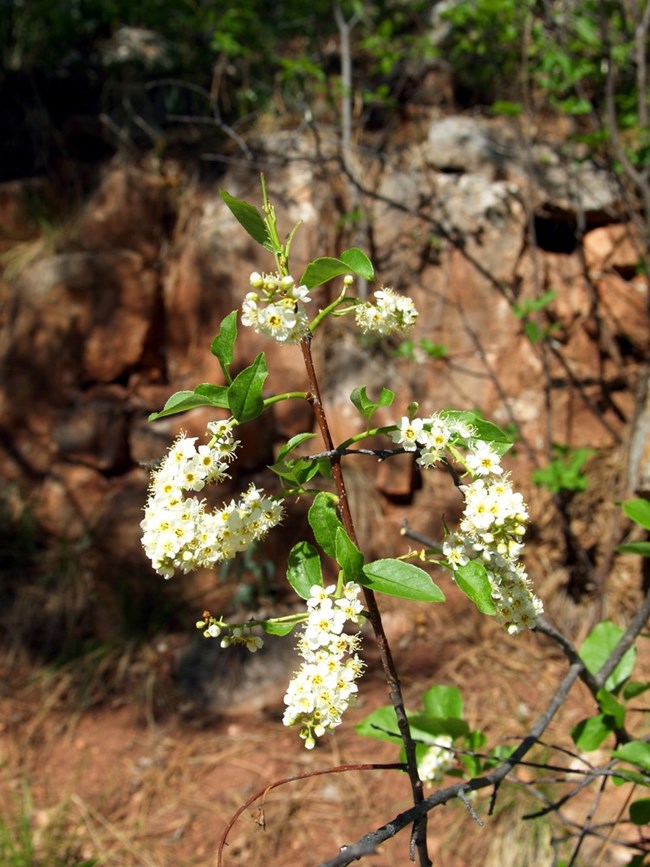Part of a series of articles titled Park Air Profiles.
Previous: Park Air Profiles - Index
Article
Most visitors expect clean air and good visibility in parks. However, Acadia National Park (NP), Maine, is downwind from large urban and industrial areas in the states to the south and west. Polluted air coming from these areas is trapped by the park’s steep slopes and high peaks. Over 30 years of air quality monitoring has shown that Acadia NP receives some of the highest levels of pollution in the northeastern U.S. Air pollution can harm ecosystems, scenic vistas, and public health. This is one of the most important environmental issues facing the park. The National Park Service works to address air pollution effects at Acadia NP, and in parks across the U.S., through science, policy and planning, and by doing our part.

Nitrogen (N) and sulfur (S) compounds deposited from the air may have harmful effects on ecosystem processes. Healthy ecosystems can naturally buffer a certain amount of pollution, but once a threshold is passed the ecosystem may respond negatively. This threshold is the critical load, or the amount of pollution above which harmful changes in sensitive ecosystems occur (Porter 2005). N and S deposition change ecosystems through eutrophication (N deposition) and acidification (N + S deposition). Eutrophication increases soil and water nutrients which causes some species to grow more quickly and changes community composition. Ecosystem sensitivity to nutrient N enrichment at Acadia National Park (ACAD) relative to other national parks is low (Sullivan et al. 2016); for a full list of N sensitive ecosystem components, see: NPS ARD 2019. Acidification leaches important cations from soils, lakes, ponds, and streams which decreases habitat quality. Ecosystem sensitivity to acidification at ACAD relative to other national parks is very high (Sullivan et al. 2016); to search for acid-sensitive plant species, see: NPSpecies.
From 2017-2019 total N deposition in ACAD ranged from 3.0 to 3.2 kg-N ha-1 yr-1 and total S deposition ranged from 2.4 to 2.5 kg-S ha-1 yr-1 based on the TDep model (NADP, 2018). ACAD has been monitoring atmospheric N and S deposition since 1981, see the conditions and trends website for park-specific information.
Surface waters and vegetation on ACAD’s high peaks and steep slopes with shallow soils and resistant bedrock that is unable to buffer excess acids are particularly sensitive.
Additional N and S Research:Epiphytic macrolichens grow on tree trunks, branches, and boles. Since these lichens grow above the ground, they obtain all their nutrients directly from precipitation and the air. Many epiphytic lichen species have narrow environmental niches and are extremely sensitive to changes in air pollution. Geiser et al. (2019) used a U.S. Forest Service national survey to develop critical loads of nitrogen (N) and critical loads of sulfur (S) to prevent more than a 20% decline in four lichen community metrics: total species richness, pollution sensitive species richness, forage lichen abundance, and cyanolichen abundance.
McCoy et al. (2021) used forested area from the National Land Cover Database to estimate the impact of air pollution on epiphytic lichen communities. Forested area makes up 121 km2 (79.5%) of the land area of Acadia National Park.
For exceedances of other lichen metrics and the predicted decline of lichen communities see Appendices A and B of McCoy et al. (2021).
Additional modeling was done on 459 lichen species to test the combined effects of air pollution and climate gradients (Geiser et al. 2021). A critical load indicative of initial shifts from pollution-sensitive toward pollution-tolerant species occurred at 1.5 kg-N ha-1 yr-1 and 2.7 kg-S ha-1 yr-1 even under changing climate regimes.
Plants vary in their tolerance of eutrophication and acidification, and some plant species respond to nitrogen (N) or sulfur (S) pollution with declines in growth, survival, or abundance on the landscape. Horn et al. (2018) used the U.S. Forest Service national forest survey to develop critical loads of N and critical loads of S to prevent declines in growth or survival of sensitive tree species. Clark et al. (2019) used a database of plant community surveys to develop critical loads of N and critical loads of S to prevent a decline in abundance of sensitive herbaceous plant species. According to NPSpecies, Acadia National Park contains:
The maps below show how the spatial distribution of estimated Total N and Total S deposition in ACAD has changed from 2000-2002 to 2019-2021 (TDep MMF version 2022.02). Slide the arrows in the middle of the image up and down to compare N and S deposition between the two years (Yearly Data).


Pollutants like mercury and pesticides are concerning because they are persistent and toxic in the environment. These contaminants can travel in the air thousands of miles away from the source of pollution, even depositing in protected places like national parks. In addition, while some of these harmful pollutants may be banned from use, historically contaminated sites continue to endure negative environmental consequences.
When deposited, airborne mercury and other toxic air contaminants are known to harm wildlife like birds and fish, and cause human health concerns. Many of these substances enter the food chain and accumulate in the tissue of organisms causing reduced reproductive success, impaired growth and development, and decreased survival.


At ground level, ozone is harmful to human health and the environment. Ground-level ozone does not come directly from smokestacks or vehicles, but instead is formed when other pollutants, mainly nitrogen oxides and volatile organic compounds, react in the presence of sunlight.
Over the course of a growing season, ozone can damage plant tissues making it harder for plants to grow and store carbon. Ozone causes leaf injuries like bleaching or dark spots on some sensitive plants, and park surveys in the 1990s found ozone injury on dogbane and big-leaf aster (Eckert et al. 1999). There are 15 plants that may display ozone leaf injury at Acadia National Park. Search ozone-sensitive plant species found at Acadia National Park.
US Environmental Protection Agency and NPS found in ozone exposure experiments that ozone slowed tree seedling growth. NPS uses W126 values from averaged seedling responses in those experiments to describe park condition in terms of Vegetation Health. Ozone affects actively growing plants, so the W126 metric weights a sum of ozone concentrations during daylight hours over three months in the growing season.
A recent re-analysis of the seedling experiments established critical levels of ozone protective of each tree species tested (Lee et al. 2022). The ozone critical levels are W126 values that will prevent 5% or greater deficit in tree seedling biomass. Air Quality Conditions and Trends reports a 5-year average of W126 for each park. In 2018-2022, the average W126 values for Acadia National Park was 3.7 and 4.2 ppm-h at the two in park monitors. Based on these ozone level, trees present in the park (NPSpecies) are at risk of the following ozone effects:
The tree species black cherry (Prunus serotina), with an ozone critical level of 2.5 ppm-h, is at risk of 7-8% biomass deficit in seedlings. Recent ozone levels in the park exceed critical levels that protect this species.
Tree species quaking aspen (Populous tremuloides), red maple (Acer rubrum), white pine (Pinus strobus) and sugar maple (Acer saccharum) are at low risk from ozone despite their known sensitivity. Recent ozone levels in the park are below critical levels that protect these trees from 5% biomass deficit.
Ozone critical levels are for tree seedlings, which represent the regenerative capacity and long-term stability of sensitive species within a forest. These tree species are also known to be sensitive to ozone as adults (Bell et al. 2020), but critical values for seedling growth do not predict ozone effects on adult trees. Bartholomay et al. 1997 found that mature white pines in the park had growth deficits correlated with ozone levels rather than climate. Air Resources Division is currently working with collaborators to establish critical levels for other mature trees species using data from forest monitoring plots.
Visit the NPS air quality conditions and trends website for park-specific ozone information. Acadia NP has been monitoring ozone since 1995. View live ozone and meteorology data.
Bank, M.S., Burgess, J., Evers, D. and Loftin, C. 2007a. Mercury contamination of biota from Acadia National Park, Maine: a review. Environmental Monitoring and Assessment 126(1–3): 105–115.
Bank, M.S., Crocker, J., Connery, B. and Amirbahman, A. 2007b. Mercury bioaccumulation in green frog (Rana clamitans) and bullfrog (Rana catesbeiana) tadpoles from Acadia National Park, Maine, USA. Environmental Toxicology and Chemistry 26(1): 118–125.
Bartholomay, G.A., Eckert, R.T. and Smith, K.T. 1997. Reductions in tree-ring widths of white pine following ozone exposure at Acadia National Park, Maine, U.S.A. Canadian Journal of Forest Research 27: 361-368. https://irma.nps.gov/DataStore/Reference/Profile/2178346
Bell MD, Felker-Quinn E, Kohut R. 2020. Ozone sensitive plant species on National Park Service lands. Natural Resource Report. NPS/WASO/NRR—2020/2062. National Park Service. Fort Collins, Colorado. https://irma.nps.gov/DataStore/Reference/Profile/2271702
Burri, K., C. Gromke, and F. Graf. "Mycorrhizal fungi protect the soil from wind erosion: a wind tunnel study." Land Degradation & Development 24.4 (2013): 385-392.
Cheng, Shen, et al. "Elucidating the mechanisms underlying enhanced drought tolerance in plants mediated by arbuscular mycorrhizal fungi." Frontiers in Microbiology 12 (2021): 809473.
Clark, C.M., Simkin, S.M., Allen, E.B. et al. Potential vulnerability of 348 herbaceous species to atmospheric deposition of nitrogen and sulfur in the United States. Nat. Plants 5, 697–705 (2019). https://doi.org/10.1038/s41477-019-0442-8.
Cleavitt, N.L., Ewing, H.A., Weathers, K.C., and Lindsey, A.M. 2011. Acidic atmospheric deposition interacts with tree type and impacts the cryptogamic epiphytes in Acadia National Park, Maine, USA. Bryologist 114:570-582. https://doi.org/10.1639/0007-2745-114.3.570.
Daggett, C.T., Saros, J.E., Lafrancois, B.M., Simon, K.S., and Amirbahman, A. 2015. Effects of increased concentrations of inorganic nitrogen and dissolved organic matter on phytoplankton in boreal lakes with differing nutrient limitation patterns. Aquat Sci 77: 511-521. http://dx.doi.org/10.1007/s00027-015-0396-5.
Eagles-Smith, C.A., S.J. Nelson., C.M. Flanagan Pritz, J.J. Willacker Jr., and A. Klemmer. 2018. Total Mercury Concentrations in Dragonfly Larvae from U.S. National Parks (ver. 6.0, June 2021): U.S. Geological Survey data release. https://doi.org/10.5066/P9TK6NPT
Eagles-Smith, CA, JJ Willacker, CM Flanagan Pritz, AC Ellsworth. 2019. Total Mercury Concentrations in Fish from 31 National Parks, USA, 2015-2016. USGS Sensitive Data Release. https://irma.nps.gov/DataStore/Reference/Profile/2260288
Eagles-Smith, C.A., J.J. Willacker, S.J. Nelson, C.M. Flanagan Pritz, D.P. Krabbenhoft, C.Y. Chen, J.T. Ackerman, E.H. Campbell Grant, and D.S. Pilliod. 2020. Dragonflies as biosentinels of mercury availability in aquatic food webs of national parks throughout the United States. Environmental Science and Technology 54(14):8779-8790. https://doi.org/10.1021/acs.est.0c01255
Eckert R and Others. 1999. Foliar Ozone Injury on Native Vegetation at Acadia National Park: Results From a Six-Year (1992-1997) Field Survey. The University of New Hampshire, Department of Natural Resources and The Boyce Thompson Institute for Plant Research. Durham, NH & Ithaca, NY. https://irma.nps.gov/DataStore/Reference/Profile/2179204
[EPA] U.S. Environmental Protection Agency. 2010. 2008 National Listing of Fish Advisories. Available at https://www.epa.gov/fish-tech.
Geiser, Linda & Nelson, Peter & Jovan, Sarah & Root, Heather & Clark, Christopher. (2019). Assessing Ecological Risks from Atmospheric Deposition of Nitrogen and Sulfur to US Forests Using Epiphytic Macrolichens. Diversity. 11. 87. 10.3390/d11060087.
Geiser, Linda & Root, Heather & Smith, Robert & Jovan, Sarah & Clair, Larry & Dillman, Karen. (2021). Lichen-based critical loads for deposition of nitrogen and sulfur in US forests. Environmental Pollution. 291. 118187. 10.1016/j.envpol.2021.118187.
George, Eckhard, Horst Marschner, and Iver Jakobsen. "Role of arbuscular mycorrhizal fungi in uptake of phosphorus and nitrogen from soil." Critical reviews in biotechnology 15.3-4 (1995): 257-270
Haines, T., Webber, H., and Coyle, J. 2000. An assessment of contaminant threats at Acadia National Park. National Park Service. 74 pp. Available at: https://irma.nps.gov/DataStore/Reference/Profile/2179166
Heath, R.H., Kahl, J.S., Norton, S.A. and Brutsaert, W.R. 1993. Elemental mass balances and episodic and ten–year changes in the chemistry of surface water, Acadia National Park, Maine: final report. Technical Report NPS/NAROSS/NRTR—93/16. National Park Service, North Atlantic Region, Boston, Massachusetts. 111 pp.
Horn KJ, Thomas RQ, Clark CM, Pardo LH, Fenn ME, Lawrence GB, et al. (2018) Growth and survival relationships of 71 tree species with nitrogen and sulfur deposition across the conterminous U.S.. PLoS ONE 13(10): e0205296. https://doi.org/10.1371/journal.pone.0205296.
Jiang, M. and Jagels, R. 1999. Detection and quantification of changes in membrane–associated calcium in red spruce saplings exposed to acid fog. Tree Physiology 19: 909–916.
Johnson, K.B., Haines, T. A., Kahl, J.S., Norton, S.A., Amirbahman, A. and Sheehan, K.D. 2007. Controls on mercury and methylmercury deposition for two watersheds in Acadia National Park, Maine. Environmental Monitoring and Assessment 126: 55–67.
Kahl, J.S., Manski, D., Flora, M. and Houtman, N. 2000. Water Resources Management Plan, Acadia National Park. National Park Service. 103 pp.
Kahl, J.S., Norton, S.A., Haines, T.A., Rochette, E.A., Heath, R.H. and Nodvin, S.C. 1992. Mechanisms of episodic acidification in low–order streams in Maine, USA. Environmental Pollution 78: 37–44.
Lee EH, Anderson CP, Beedlow PA, Tingey DT, Koike S, Dubois J, Kaylor SD, Novak K, Rice RB, Neufeld HS, Herrick JD. 2022. Ozone Exposure-Response Relationships Parametrized for Sixteen Tree Species with Varying Sensitivity in the United States. Atmospheric Environment. 284:1-16. https://irma.nps.gov/DataStore/Reference/Profile/2294221
Lilleskov, Erik A., et al. "Atmospheric nitrogen deposition impacts on the structure and function of forest mycorrhizal communities: a review." Environmental Pollution 246 (2019): 148-162.
Longcore, J.R., Dineli, R. and Haines, T.A. 2007a. Mercury and Growth of Tree Swallows at Acadia National Park, and at Orono, Maine, USA. Environmental Monitoring and Assessment 126 (1–3): 117–127. https://irma.nps.gov/DataStore/Reference/Profile/664081
Longcore, J.R., Haines, T.A. and Halteman, W.A. 2007b. Mercury in Tree Swallow Food, Eggs, Bodies, and Feathers at Acadia National Park, Maine, and an EPA Superfund Site, Ayer, Massachusetts. Environmental Monitoring and Assessment 126 (1–3): 129–143. Available at: https://irma.nps.gov/DataStore/Reference/Profile/664082
Matz, A.C., Gilbert, J.R., and O’Connell, A.F. 1998. Acadia’s Bald Eagles: research summary and management recommendations. National Park Service. Boston, MA. Available at: https://irma.nps.gov/DataStore/Reference/Profile/4695
McCoy K., M. D. Bell, and E. Felker-Quinn. 2021. Risk to epiphytic lichen communities in NPS units from atmospheric nitrogen and sulfur pollution: Changes in critical load exceedances from 2001‒2016. Natural Resource Report NPS/NRSS/ARD/NRR—2021/2299. National Park Service, Fort Collins, Colorado. https://doi.org/10.36967/nrr-2287254.
Mierzykowski SE and Others. 2013. Contaminant assessment of coastal bald eagles at Maine Coastal Islands National Wildlife Refuge and Acadia National Park. Special Project Report: FY12-MEFO-2-EC. U.S. FIsh and Wildlife Service, Maine Field Office, Maine. Available at: https://irma.nps.gov/DataStore/Reference/Profile/2204542
[NADP] National Atmospheric Deposition Program. 2018. NTN Data. Accessed January 20, 2022. Available at http://nadp.slh.wisc.edu/NADP/.
Nelson, S.J., Johnson, K.B., Weathers, K.C., Loftin, C.S., Fernandez, I.J., Kahl, J.S. and Krabbenhoft, D.P. 2008. A comparison of winter mercury accumulation at forested and no canopy sites measured with different snow sampling techniques. Applied Geochemistry 23(3): 384–398.
[NPS] National Park Service. 2022. Fish Consumption Advisories. https://www.nps.gov/subjects/fishing/fish-consumption-advisories.htm
Peckenham, J.M., Kahl, J.S. and Amirbahman, A. 2006. The impact of vehicular traffic on water quality in Acadia National Park. Technical report NPS/NER/NRTR–2006/035. National Park Service, Boston, MA. Available at: https://irma.nps.gov/DataStore/Reference/Profile/2179454
Peckenham, J.M., Kahl, J.S., Nelson, S.J., Johnson, K.B. and Haines, T.A. 2007. Landscape Controls on Mercury in Streamwater at Acadia National Park, USA. Environmental Monitoring and Assessment 126(1–3): 97–104. Available at: https://irma.nps.gov/DataStore/Reference/Profile/649545
Porter, E., Blett, T., Potter, D.U., Huber, C. 2005. Protecting resources on federal lands: Implications of critical loads for atmospheric deposition of nitrogen and sulfur. BioScience 55(7): 603–612. https://doi.org/10.1641/0006-3568(2005)055[0603:PROFLI]2.0.CO;2.
Saros, J. E. 2014. Determining critical nitrogen loads to boreal lake ecosystems: The response of phytoplankton at Acadia and Isle Royale National Parks. Natural Resource Technical Report NPS/ACAD/NRTR—2014/862. National Park Service, Fort Collins, Colorado. https://irma.nps.gov/DataStore/Reference/Profile/2209241.
Smith, C.M. and Trip, L.J. 2005. Mercury Policy and Science in Northeastern North America: The Mercury Action Plan of the New England Governors and Eastern Canadian Premiers. Ecotoxicology 14: 19–35.
Sullivan T.J. 2016. Air quality related values (AQRVs) in national parks: Effects from ozone; visibility reducing particles; and atmospheric deposition of acids, nutrients and toxics. Natural Resource Report. NPS/NRSS/ARD/NRR—2016/1196. National Park Service. Fort Collins, Colorado. Available at https://www.nps.gov/articles/aqrv-assessment.htm.
Vaux, P.D., Nelson, S.J., Rajakaruna, N., Mittelhauser, G., Bell, K., Kopp, B., Peckenham, J., and Longsworth, G. 2008. Assessment of natural resource conditions in and adjacent to Acadia National Park, Maine. Natural Resource Report NPS/NRPC/WRD/NRR—2008/069. National Park Service, Fort Collins, Colorado. Available at https://irma.nps.gov/DataStore/Reference/Profile/2179608.
Webber, H.M. and Haines, T. 2003. Mercury effects on predator avoidance behavior of a forage fish, golden shiner (Notemigonus chrysoleucas). Envir. Tox. Chem. 22: 1556–1561. Available at: https://irma.nps.gov/DataStore/Reference/Profile/2172104
Part of a series of articles titled Park Air Profiles.
Previous: Park Air Profiles - Index
Last updated: September 4, 2024